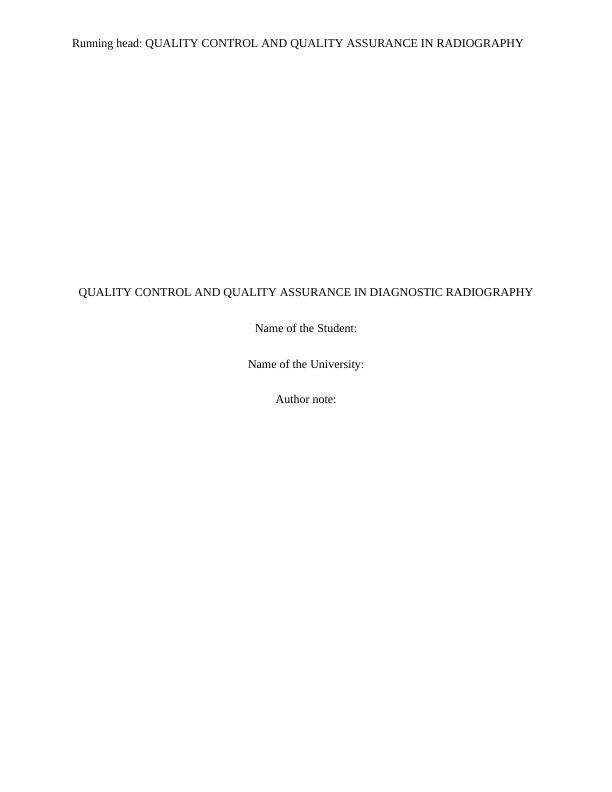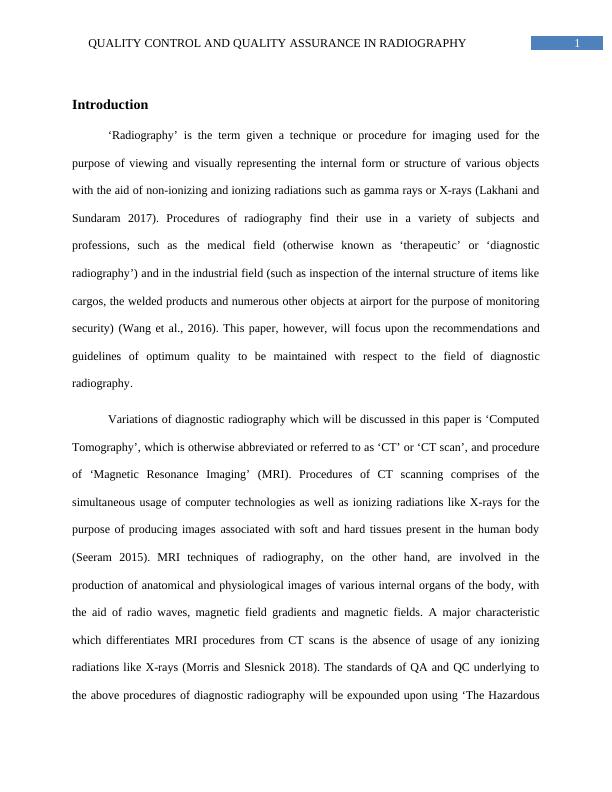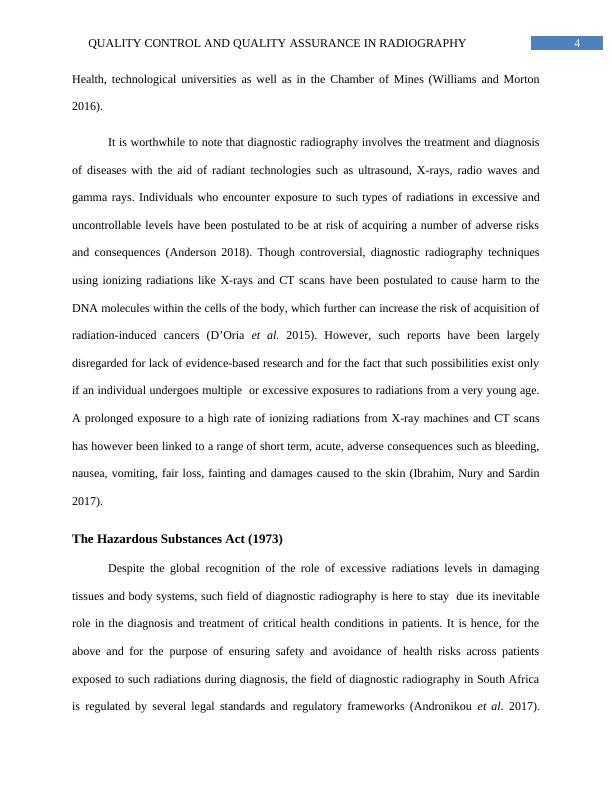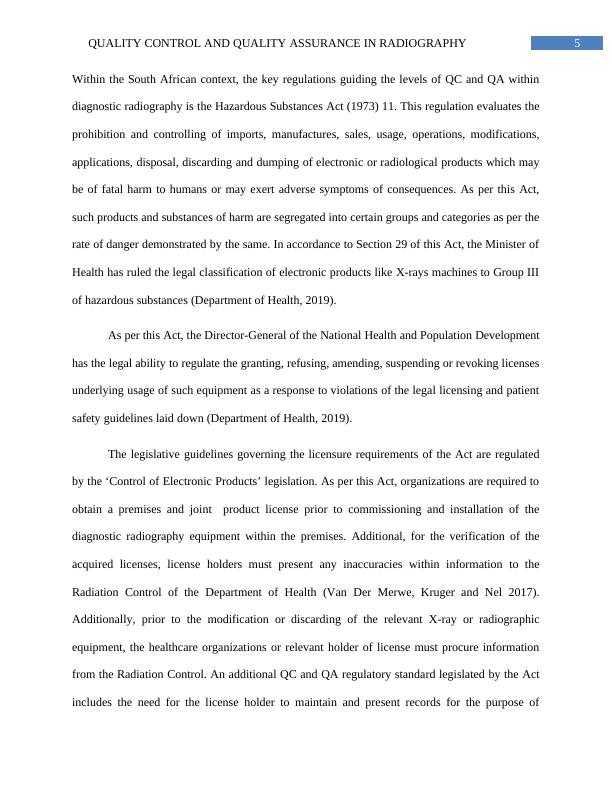Quality Control and Quality Assurance in Radiography
Added on 2022-12-23
25 Pages7184 Words75 Views
Running head: QUALITY CONTROL AND QUALITY ASSURANCE IN RADIOGRAPHY
QUALITY CONTROL AND QUALITY ASSURANCE IN DIAGNOSTIC RADIOGRAPHY
Name of the Student:
Name of the University:
Author note:
QUALITY CONTROL AND QUALITY ASSURANCE IN DIAGNOSTIC RADIOGRAPHY
Name of the Student:
Name of the University:
Author note:

1QUALITY CONTROL AND QUALITY ASSURANCE IN RADIOGRAPHY
Introduction
‘Radiography’ is the term given a technique or procedure for imaging used for the
purpose of viewing and visually representing the internal form or structure of various objects
with the aid of non-ionizing and ionizing radiations such as gamma rays or X-rays (Lakhani and
Sundaram 2017). Procedures of radiography find their use in a variety of subjects and
professions, such as the medical field (otherwise known as ‘therapeutic’ or ‘diagnostic
radiography’) and in the industrial field (such as inspection of the internal structure of items like
cargos, the welded products and numerous other objects at airport for the purpose of monitoring
security) (Wang et al., 2016). This paper, however, will focus upon the recommendations and
guidelines of optimum quality to be maintained with respect to the field of diagnostic
radiography.
Variations of diagnostic radiography which will be discussed in this paper is ‘Computed
Tomography’, which is otherwise abbreviated or referred to as ‘CT’ or ‘CT scan’, and procedure
of ‘Magnetic Resonance Imaging’ (MRI). Procedures of CT scanning comprises of the
simultaneous usage of computer technologies as well as ionizing radiations like X-rays for the
purpose of producing images associated with soft and hard tissues present in the human body
(Seeram 2015). MRI techniques of radiography, on the other hand, are involved in the
production of anatomical and physiological images of various internal organs of the body, with
the aid of radio waves, magnetic field gradients and magnetic fields. A major characteristic
which differentiates MRI procedures from CT scans is the absence of usage of any ionizing
radiations like X-rays (Morris and Slesnick 2018). The standards of QA and QC underlying to
the above procedures of diagnostic radiography will be expounded upon using ‘The Hazardous
Introduction
‘Radiography’ is the term given a technique or procedure for imaging used for the
purpose of viewing and visually representing the internal form or structure of various objects
with the aid of non-ionizing and ionizing radiations such as gamma rays or X-rays (Lakhani and
Sundaram 2017). Procedures of radiography find their use in a variety of subjects and
professions, such as the medical field (otherwise known as ‘therapeutic’ or ‘diagnostic
radiography’) and in the industrial field (such as inspection of the internal structure of items like
cargos, the welded products and numerous other objects at airport for the purpose of monitoring
security) (Wang et al., 2016). This paper, however, will focus upon the recommendations and
guidelines of optimum quality to be maintained with respect to the field of diagnostic
radiography.
Variations of diagnostic radiography which will be discussed in this paper is ‘Computed
Tomography’, which is otherwise abbreviated or referred to as ‘CT’ or ‘CT scan’, and procedure
of ‘Magnetic Resonance Imaging’ (MRI). Procedures of CT scanning comprises of the
simultaneous usage of computer technologies as well as ionizing radiations like X-rays for the
purpose of producing images associated with soft and hard tissues present in the human body
(Seeram 2015). MRI techniques of radiography, on the other hand, are involved in the
production of anatomical and physiological images of various internal organs of the body, with
the aid of radio waves, magnetic field gradients and magnetic fields. A major characteristic
which differentiates MRI procedures from CT scans is the absence of usage of any ionizing
radiations like X-rays (Morris and Slesnick 2018). The standards of QA and QC underlying to
the above procedures of diagnostic radiography will be expounded upon using ‘The Hazardous

2QUALITY CONTROL AND QUALITY ASSURANCE IN RADIOGRAPHY
Substances Act (1973)’ – the South African regulation which monitors and drives the prohibition
and control of importing, manufacturing, retailing, operating, applying, modifying or disposing
of products of electronic items which may be of potential harm or whose adverse consequences
can be induce fatal impacts upon human beings. Such regulatory legislations have been imbibed
and implemented by the Radiation Control Directorate and Department of Health of South
Africa, which will be discussed extensively in the succeeding sections of this paper (Department
of Health 2019).
The following paper will shed light on the standards of quality assurance and quality
control which are to be maintained within the South African context. This paper will also
demonstrate a succinct discussion on the South African guidelines of quality control (QC) and
quality assurance (QA) which are to be maintained for procedures like computer tomography
(CT) as well as Magnetic Resonance Imaging (MRI). A succinct discussion of relevant tests of
QC and QA in terms of their purpose, their importance, levels of frequency, procedures, results
or values of acceptability as well as unacceptability and associated corrective actions will
comprise of the scope of this paper.
Discussion
Diagnostic Radiography as a Profession
The discipline of Diagnostic Radiography involves positioning patients for the purpose of
recording, investigation and evaluation of the various organs and anatomical sections of the body
by capturing images using non-ionizing or ionizing techniques like X-rays. Diagnostic
Radiographers engage in the field of diagnostic radiography – and hence, are involved in the
performance of imaging procedures for the purpose of diagnosing, treating and monitoring of
Substances Act (1973)’ – the South African regulation which monitors and drives the prohibition
and control of importing, manufacturing, retailing, operating, applying, modifying or disposing
of products of electronic items which may be of potential harm or whose adverse consequences
can be induce fatal impacts upon human beings. Such regulatory legislations have been imbibed
and implemented by the Radiation Control Directorate and Department of Health of South
Africa, which will be discussed extensively in the succeeding sections of this paper (Department
of Health 2019).
The following paper will shed light on the standards of quality assurance and quality
control which are to be maintained within the South African context. This paper will also
demonstrate a succinct discussion on the South African guidelines of quality control (QC) and
quality assurance (QA) which are to be maintained for procedures like computer tomography
(CT) as well as Magnetic Resonance Imaging (MRI). A succinct discussion of relevant tests of
QC and QA in terms of their purpose, their importance, levels of frequency, procedures, results
or values of acceptability as well as unacceptability and associated corrective actions will
comprise of the scope of this paper.
Discussion
Diagnostic Radiography as a Profession
The discipline of Diagnostic Radiography involves positioning patients for the purpose of
recording, investigation and evaluation of the various organs and anatomical sections of the body
by capturing images using non-ionizing or ionizing techniques like X-rays. Diagnostic
Radiographers engage in the field of diagnostic radiography – and hence, are involved in the
performance of imaging procedures for the purpose of diagnosing, treating and monitoring of

3QUALITY CONTROL AND QUALITY ASSURANCE IN RADIOGRAPHY
injuries or diseases (Naylor, Ferris and Burton 2016). Radiographers implement the professional
tasks by using advanced technologies such as X-ray equipments, CT scanners or mammography
equipments, which then capture images. The images produced by these machineries may then be
displayed with the assistance of movie or X-ray films, television monitors, videotapes or simply
read out from monitors. The presence of any form of abnormalities in the body will be detected
within these images which further enable radiologists to provide an appropriate diagnosis to
patient (Sloane and Miller 2017).
Radiographers are however, not to be confused to the professional scope of practice held
by radiologists. Radiologists are entrusted with the responsibility of interpreting the images
generated by the diagnostic radiography equipment. In comparison, the scope of practice of a
diagnostic radiographer is limited to only producing such images via usage of relevant
equipment (Elshami and Abdalla 2017). For optimum professional practice as per national legal
standards and regulations, diagnostic radiographers who are qualified must register themselves
with the Health Professionals Council of South Africa (Department of Health 2019). Registered
diagnostic radiographers are required to engage in the usage of a wide range of diagnostic
techniques such as X-rays, computer tomography, radioactive isotope imaging, ultrasound and
magnetic resonance imaging. Within healthcare organizations, diagnostic radiographer have the
scope of functioning within numerous departments such as in the operation theaters, the
emergency and accident departments, imaging departments as well as across various wards
(Naidoo, Lawrence and Stein 2018). Within the South African context, in addition to practicing
in privatized or self-employment ventures, registered diagnostic radiographers also have the
scope to be recruited by clinics and hospitals controlled by the government, the Department of
injuries or diseases (Naylor, Ferris and Burton 2016). Radiographers implement the professional
tasks by using advanced technologies such as X-ray equipments, CT scanners or mammography
equipments, which then capture images. The images produced by these machineries may then be
displayed with the assistance of movie or X-ray films, television monitors, videotapes or simply
read out from monitors. The presence of any form of abnormalities in the body will be detected
within these images which further enable radiologists to provide an appropriate diagnosis to
patient (Sloane and Miller 2017).
Radiographers are however, not to be confused to the professional scope of practice held
by radiologists. Radiologists are entrusted with the responsibility of interpreting the images
generated by the diagnostic radiography equipment. In comparison, the scope of practice of a
diagnostic radiographer is limited to only producing such images via usage of relevant
equipment (Elshami and Abdalla 2017). For optimum professional practice as per national legal
standards and regulations, diagnostic radiographers who are qualified must register themselves
with the Health Professionals Council of South Africa (Department of Health 2019). Registered
diagnostic radiographers are required to engage in the usage of a wide range of diagnostic
techniques such as X-rays, computer tomography, radioactive isotope imaging, ultrasound and
magnetic resonance imaging. Within healthcare organizations, diagnostic radiographer have the
scope of functioning within numerous departments such as in the operation theaters, the
emergency and accident departments, imaging departments as well as across various wards
(Naidoo, Lawrence and Stein 2018). Within the South African context, in addition to practicing
in privatized or self-employment ventures, registered diagnostic radiographers also have the
scope to be recruited by clinics and hospitals controlled by the government, the Department of

4QUALITY CONTROL AND QUALITY ASSURANCE IN RADIOGRAPHY
Health, technological universities as well as in the Chamber of Mines (Williams and Morton
2016).
It is worthwhile to note that diagnostic radiography involves the treatment and diagnosis
of diseases with the aid of radiant technologies such as ultrasound, X-rays, radio waves and
gamma rays. Individuals who encounter exposure to such types of radiations in excessive and
uncontrollable levels have been postulated to be at risk of acquiring a number of adverse risks
and consequences (Anderson 2018). Though controversial, diagnostic radiography techniques
using ionizing radiations like X-rays and CT scans have been postulated to cause harm to the
DNA molecules within the cells of the body, which further can increase the risk of acquisition of
radiation-induced cancers (D’Oria et al. 2015). However, such reports have been largely
disregarded for lack of evidence-based research and for the fact that such possibilities exist only
if an individual undergoes multiple or excessive exposures to radiations from a very young age.
A prolonged exposure to a high rate of ionizing radiations from X-ray machines and CT scans
has however been linked to a range of short term, acute, adverse consequences such as bleeding,
nausea, vomiting, fair loss, fainting and damages caused to the skin (Ibrahim, Nury and Sardin
2017).
The Hazardous Substances Act (1973)
Despite the global recognition of the role of excessive radiations levels in damaging
tissues and body systems, such field of diagnostic radiography is here to stay due its inevitable
role in the diagnosis and treatment of critical health conditions in patients. It is hence, for the
above and for the purpose of ensuring safety and avoidance of health risks across patients
exposed to such radiations during diagnosis, the field of diagnostic radiography in South Africa
is regulated by several legal standards and regulatory frameworks (Andronikou et al. 2017).
Health, technological universities as well as in the Chamber of Mines (Williams and Morton
2016).
It is worthwhile to note that diagnostic radiography involves the treatment and diagnosis
of diseases with the aid of radiant technologies such as ultrasound, X-rays, radio waves and
gamma rays. Individuals who encounter exposure to such types of radiations in excessive and
uncontrollable levels have been postulated to be at risk of acquiring a number of adverse risks
and consequences (Anderson 2018). Though controversial, diagnostic radiography techniques
using ionizing radiations like X-rays and CT scans have been postulated to cause harm to the
DNA molecules within the cells of the body, which further can increase the risk of acquisition of
radiation-induced cancers (D’Oria et al. 2015). However, such reports have been largely
disregarded for lack of evidence-based research and for the fact that such possibilities exist only
if an individual undergoes multiple or excessive exposures to radiations from a very young age.
A prolonged exposure to a high rate of ionizing radiations from X-ray machines and CT scans
has however been linked to a range of short term, acute, adverse consequences such as bleeding,
nausea, vomiting, fair loss, fainting and damages caused to the skin (Ibrahim, Nury and Sardin
2017).
The Hazardous Substances Act (1973)
Despite the global recognition of the role of excessive radiations levels in damaging
tissues and body systems, such field of diagnostic radiography is here to stay due its inevitable
role in the diagnosis and treatment of critical health conditions in patients. It is hence, for the
above and for the purpose of ensuring safety and avoidance of health risks across patients
exposed to such radiations during diagnosis, the field of diagnostic radiography in South Africa
is regulated by several legal standards and regulatory frameworks (Andronikou et al. 2017).

5QUALITY CONTROL AND QUALITY ASSURANCE IN RADIOGRAPHY
Within the South African context, the key regulations guiding the levels of QC and QA within
diagnostic radiography is the Hazardous Substances Act (1973) 11. This regulation evaluates the
prohibition and controlling of imports, manufactures, sales, usage, operations, modifications,
applications, disposal, discarding and dumping of electronic or radiological products which may
be of fatal harm to humans or may exert adverse symptoms of consequences. As per this Act,
such products and substances of harm are segregated into certain groups and categories as per the
rate of danger demonstrated by the same. In accordance to Section 29 of this Act, the Minister of
Health has ruled the legal classification of electronic products like X-rays machines to Group III
of hazardous substances (Department of Health, 2019).
As per this Act, the Director-General of the National Health and Population Development
has the legal ability to regulate the granting, refusing, amending, suspending or revoking licenses
underlying usage of such equipment as a response to violations of the legal licensing and patient
safety guidelines laid down (Department of Health, 2019).
The legislative guidelines governing the licensure requirements of the Act are regulated
by the ‘Control of Electronic Products’ legislation. As per this Act, organizations are required to
obtain a premises and joint product license prior to commissioning and installation of the
diagnostic radiography equipment within the premises. Additional, for the verification of the
acquired licenses, license holders must present any inaccuracies within information to the
Radiation Control of the Department of Health (Van Der Merwe, Kruger and Nel 2017).
Additionally, prior to the modification or discarding of the relevant X-ray or radiographic
equipment, the healthcare organizations or relevant holder of license must procure information
from the Radiation Control. An additional QC and QA regulatory standard legislated by the Act
includes the need for the license holder to maintain and present records for the purpose of
Within the South African context, the key regulations guiding the levels of QC and QA within
diagnostic radiography is the Hazardous Substances Act (1973) 11. This regulation evaluates the
prohibition and controlling of imports, manufactures, sales, usage, operations, modifications,
applications, disposal, discarding and dumping of electronic or radiological products which may
be of fatal harm to humans or may exert adverse symptoms of consequences. As per this Act,
such products and substances of harm are segregated into certain groups and categories as per the
rate of danger demonstrated by the same. In accordance to Section 29 of this Act, the Minister of
Health has ruled the legal classification of electronic products like X-rays machines to Group III
of hazardous substances (Department of Health, 2019).
As per this Act, the Director-General of the National Health and Population Development
has the legal ability to regulate the granting, refusing, amending, suspending or revoking licenses
underlying usage of such equipment as a response to violations of the legal licensing and patient
safety guidelines laid down (Department of Health, 2019).
The legislative guidelines governing the licensure requirements of the Act are regulated
by the ‘Control of Electronic Products’ legislation. As per this Act, organizations are required to
obtain a premises and joint product license prior to commissioning and installation of the
diagnostic radiography equipment within the premises. Additional, for the verification of the
acquired licenses, license holders must present any inaccuracies within information to the
Radiation Control of the Department of Health (Van Der Merwe, Kruger and Nel 2017).
Additionally, prior to the modification or discarding of the relevant X-ray or radiographic
equipment, the healthcare organizations or relevant holder of license must procure information
from the Radiation Control. An additional QC and QA regulatory standard legislated by the Act
includes the need for the license holder to maintain and present records for the purpose of

End of preview
Want to access all the pages? Upload your documents or become a member.
Related Documents
Report on Imaging Modalitieslg...
|7
|1251
|286
CBCT Imaging in Dentistry: History, Techniques, and Radiation Protectionlg...
|25
|11050
|317
Diagnostic Imaging Techniques in Paediatric Cancerlg...
|11
|3061
|438
DICOM Database for Automated Radiation Dose Tracking and Quality monitoringlg...
|5
|754
|248
Medical Imaging: Colorectal Cancer Case Analysis 2022lg...
|15
|4602
|37
